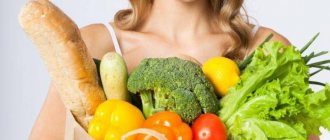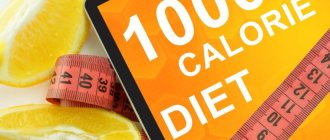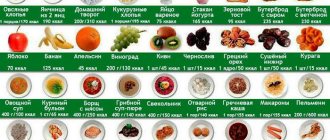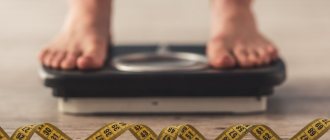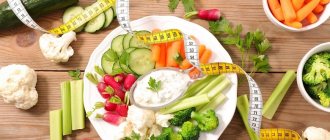Reducing calories in your diet is perhaps one of the fastest ways to lose weight. However, nutritionists do not recommend getting carried away with such nutrition.
You can create your own menu and recipes for the 900 calorie diet.
You just need to follow the table of caloric content of foods, without going beyond the permitted limits.
900 calorie diet requirements
While on a diet, 900 calories are on the forbidden list.
The following products are included: - flour products (you can leave only a little rye bread in the diet); - fats and oils; - fatty dairy and meat products; — jam, honey, chocolate, cakes and other sweets; — fast food products; - pickled, smoked, overly salted foods.
It’s better to give up salt altogether for a week, and you also need to eliminate sugar in any form (both in foods and drinks).
The basis of the diet
you should make: - lean meat (priority is skinless chicken and beef); - non-starchy vegetables and fruits (primarily apples), various berries; - greenery; - chicken eggs; - low-fat dairy and fermented milk products.
It is recommended to stick to small meals and eat at least five times a day. The daily minimum of clean water should be one and a half liters. You can also drink tea and coffee, but without sugar. Occasionally it is allowed to add a small amount of low-fat milk to these drinks. Tea can be acidified with lemon juice or a slice of this citrus. It is allowed to enter into the menu, adding to the total calorie content, compotes, uzvar from fruits and dried fruits. Other drinks, especially those containing alcohol, should be avoided.
You can use the ready-made 900-calorie weekly menu described below, or you can create the menu yourself at your own discretion. The main thing is to take into account the basic requirements for choosing products.
Since the calorie content of the diet is quite low, with such a diet it is advisable to give up physical activity and not engage in work that requires serious energy expenditure. Of course, the diet rules don’t encourage you to sit completely motionless. The developers of the methodology advise limiting yourself to walking.
It is very important to gradually exit such a low-calorie diet. You should increase your caloric intake gradually, adding no more than 200 units daily until you reach your ideal figure at which your weight will be stable. If you add calories too sharply, there is a high probability that the excess weight that you worked so hard to get rid of will return and digestive problems will arise. There is no need to immediately after finishing the diet lean on foods that you refused. It is advisable, as before, to consume high-calorie flour and sweet foods in minimal quantities.
Repeated diet
Any diet is harmful to the body, as it involves consuming a minimum amount of calories. In order to avoid having to restore your health after losing weight, it is not recommended to follow low-calorie diets more often than once every 3-4 months.

To maintain longer-term weight loss results, you can eat according to the principle of a healthy diet, excluding fatty, fried, starchy foods and sweets from your diet. And to create a calorie deficit, intense physical activity in the form of strength and cardio training is suitable.
Example of a weekly 900 calorie diet menu
Monday
Breakfast: a piece of boiled beef weighing 100 g; 20 g green peas; half an apple; coffee. Snack: boiled chicken egg. Lunch: a bowl of vegetable soup without frying; lean boiled meat (up to 100 g); small cucumber; a glass of dried fruit compote. Afternoon snack: apple weighing about 200 g. Dinner: boiled or baked fish (100 g); 3 tbsp. l. white cabbage salad dressed with lemon juice.
Tuesday
Breakfast: a piece of boiled beef weighing 100 g; tea or coffee. Snack: chicken egg, boiled or fried in a frying pan without adding oil; a cup of coffee or tea. Lunch: bowl of lean borscht; lean beef stroganoff; a glass of fruit compote. Afternoon snack: raw or baked apple. Dinner: steamed chicken fillet (100 g).
Wednesday
Breakfast: steamed carrot soufflé; small apple; a cup of coffee. Snack: soft-boiled or poached egg. Lunch: bowl of lean cabbage soup; about 100 g of dry-fried or boiled fish. Afternoon snack: an apple weighing about 200 g. Dinner: a slice of boiled beef fillet; a cup of tea with a little low-fat milk.
Thursday
Breakfast: a couple of small pieces of jellied fish; tea or coffee. Snack: boiled chicken egg. Lunch: a small plate of vegetarian soup (possibly with added potatoes); slice of steamed beef; fresh cucumber; tea. Afternoon snack: apple weighing about 200 g. Dinner: boiled fish (100 g); a couple of tablespoons of shredded white cabbage with herbs.
Friday
Breakfast: 100 g of jellied fish; tea or coffee. Snack: chicken egg cooked in a frying pan without fat. Lunch: a bowl of vegetable soup without frying; 3-4 tbsp. l. vegetable stew interspersed with any lean meat. Afternoon snack: berries (about 200 g). Dinner: boiled chicken egg.
Saturday
Breakfast: steam cutlet from low-fat minced fish; coffee or tea. Snack: 200 ml low fat milk. Lunch: a small bowl of soup with pieces of carrots and barley; 100 g lean meat stroganoff; 3-4 tbsp. l. beetroot and sauerkraut salad. Afternoon snack: 200 g raspberries. Dinner: boiled meat (about 50 g).
Sunday
Breakfast: a glass of kefir or plain yogurt. Snack: steamed or boiled fish (up to 100 g). Lunch: bowl of vegetable soup; slice of boiled chicken; a couple of fresh cucumbers; tea. Afternoon snack: apple or berries (200 g). Dinner: up to 100 g of boiled chicken fillet and 20 g of peas as a side dish.
Note. Every day before going to bed, you can drink a little low-fat kefir or yogurt. This snack contains minimal calories, and it will probably be much easier to fall asleep.
Dish recipes
Add to the menu:
Steamed pork
You will need: lean pork - half a kilogram, peas in pods - one hundred and fifty grams, rice flour - one hundred grams, ginger - one gram, two tablespoons of soy sauce, one tablespoon of wine, leeks, spices.
Cut the pork into small pieces. Also chop the leeks and chop the ginger. Mix all ingredients, season with wine and soy sauce. Let it brew for one hour. Next, roll the pork slices in rice flour and place in a dish. Add pea pods to the remaining sauce and pour over the meat. Steam the meat for about two hours.
Silver carp with rice
You will need: half a kilogram of silver carp, one onion, two cloves of garlic, fifty grams of rice, spices, herbs.
Slice the fish and season with spices. Place fried onions, finely chopped garlic and herbs, boiled rice, and fish on top. Fill with water and cook until tender over low heat.
Boiled mackerel
You will need: a kilogram of mackerel, a liter of water, an onion, one carrot, herbs, spices, bay leaf, a teaspoon of vinegar.
Prepare the mackerel and place it in hot water, add seasonings and simmer over low heat for twenty minutes. Cool, cut out the fillet, place on a dish, pour with sour cream or tomato sauce. You can serve boiled potatoes, vegetables or salad as a side dish.
Boiled smelt
For the recipe you need: smelt - seven hundred grams, two heads of onions, bay leaf, pepper, herbs.
Wash and cook the cleaned fish, add onion, bay leaf, and pepper. Be careful not to overcook the fish. Place the finished fish on a dish and pour over the broth. Garnish with finely chopped herbs. Can be served with sauce.
Catfish with cabbage
You will need: catfish - half a kilogram, sauerkraut - three hundred grams, flour, spices, two tablespoons of low-fat sour cream.
Chop the fish into slices. Boil the sauerkraut. Add flour dressing with spices to the cabbage. Next, add the catfish and cook for forty minutes. Add sour cream.
Contraindications for the 900 calorie diet
- This low-calorie method should not be followed by women who are pregnant or breastfeeding, children under 18 years of age, or older people.
- You should not go on a 900 calorie diet if you have any health problems or have recently had surgery.
- An unquestioning ban is the presence of diseases affecting the gastrointestinal tract.
- The taboo for following the described rules is active sports.
- Professional athletes and people whose activities require considerable energy consumption definitely do not need to lose weight like this.
- In addition, you cannot seek help from a 900-calorie diet if you are noticeably overweight. Such people need to consume more calories so as not to experience a loss of strength and develop additional problems with the functioning of the body.
What's behind losing weight?
After all, how does weight loss happen? Many people mistakenly believe that by maintaining a negative calorie balance (we spend more than we receive).
However, cutting back on your diet does not directly lead to weight loss. The human body can very quickly adapt to changing living conditions. As soon as you limit your menu to an indecent 900 or even 600 calories, the body turns on “energy saving” mode.
What is this? In slowing down metabolic processes. And the slower the metabolism, the slower the weight loss (here is the paradox). Moreover, once you return to your previous diet, you won’t be on a 900-calorie diet forever, will you? Or will you?

Your body begins to actively store for future use everything that you have deprived it of. This is why people after a diet not only gain the weight they lost, but gain even more.
In addition, without receiving the required amount of the same carbohydrates, the body begins to burn energy from its reserves. But he takes it out of the muscle mass, depriving you of strength and endurance.
Achieving the dream shape by radical means leads to insufficient receipt of micro- and macroelements, vitamins, and other useful substances.
The harm of low-calorie diets is obvious to all nutritionists. At a minimum, sudden weight loss can cause:
- Metabolic disease
- Hormonal imbalances
- Depression, chronic weakness and fatigue
- Exacerbation of diseases
Benefits of the 900 calorie diet
- During the diet, excess weight is actively lost. In a short period of time you can significantly correct your figure.
- It is convenient to eat according to the proposed scheme both at home and at work.
- There is a fairly wide selection of permitted products, and you can create a menu taking into account your desires.
- The dishes offered on the 900 calorie diet are simple and do not require much time to prepare.
- Unlike many weight loss methods, this diet does not force you to actively engage in sports (this can only be a disadvantage for professional athletes).
Useful tips
- When cooking meat and fish, be sure to remove the skin. To reduce the fat content, it is best to steam or bake in the oven.
- The recommended portion of meat or fish per meal should not exceed 100 g. For convenience, you can cook the whole fish, and then divide it into several servings.
- To prevent hunger, include soups and hot vegetable dishes in your menu. As a snack, you can use vegetables that do not require heat treatment: sweet peppers, carrots, cucumbers, tomatoes.
- Be sure to drink water (1.5 liters). This will help normalize metabolism and speed up the weight loss process.
Disadvantages of the 900 Calorie Diet
- Please note that you cannot eat 900 calories a day for a long time. This is dangerous to health, can cause various diseases, cause muscle wasting and slow down metabolism.
- Doctors recommend that women with such a low-calorie diet be sure to consume vegetable fats in order to maintain a stable menstrual cycle. You need to not only monitor your figure, but also be attentive to your health.
- Some people on this diet have reported feeling very weak and even dizzy. In such cases, it is imperative to stop following the technique.
- With a 900 calorie diet you won’t lose very many kilograms, since you can stick to it with minimal risk of harm to your health for only one week.
- The diet may not be suitable for people who do not have the opportunity to eat small meals.
Drinking regime
Compliance with the drinking regime plays an important role during weight loss. Water starts metabolic processes and normalizes the water-salt balance in the body. With its lack, the well-being and condition of the skin worsens. Often people confuse the feeling of thirst with the feeling of hunger, which leads to overeating, and this interferes with the process of losing weight.
An adult needs to drink 30 ml per 1 kg of weight. On average, this is 2-2.5 liters of liquid per day.
If you are following a diet, you should drink water before each meal, 30 minutes before meals. Drink 2 glasses of water immediately after waking up, and then distribute the recommended amount of liquid throughout the day.
Secret method for losing weight
Meanwhile, as already mentioned, it is not at all necessary to torture yourself like that. What to do, you ask? The secret is simple.
You just need to choose the right food, because what matters to our body is not the quantity of food, but its quality. It's like if you really want to drink - what would you choose - water from a dirty puddle or a glass of clean water? It's the same with food.
They have been saying for a long time that it’s not about calories, but what kind of calories you eat.

The essence lies in...
The work of American nutrition researcher Jonathan Baylor, “It’s Not About the Calories,” is very informative in this regard, in which the author says that fasting is harmful, and food is not our enemy at all.
Since the 1970s, Jonathan says, we've been told to diet and work out at the gym. But the more we do this, the more people become obese and diabetic.
This has never happened in history. But before, no one knew what calories were, and, however, the percentage of people getting sick was much lower. What's the matter?
What secret did our ancestors know that we have now forgotten? How did people previously manage to stay slim and maintain a normal weight without any weight loss techniques? The answers are simple.
First of all, you need to stop starving yourself, going on all sorts of diets and counting calories.
Instead, you need to trust common sense and simple biology. And control the quality of the products entering our body, and not their quantity.
What determines the quality of calories? From four factors.
- Satiety - depends on how quickly calories fill the body and how long we stay full
- Aggressiveness - the likelihood of how quickly they will be deposited as fat
- Nutritional capacity - how many nutrients enter the body along with calories
- Efficiency is determined by how many of the calories the body can store as fat.
The secret to losing weight according to Baylor is simple - follow the principles of nutrition, eat the right foods, those that contain a lot of water, fiber and protein.
After all, what is high quality food?,
says the author of the book?

This is a healthy, natural food:
- low carb vegetables,
- nutritious proteins (seafood, poultry or grass-fed beef),
- eggs,
- low-sugar fruits (such as berries or citrus fruits),
- nuts and seeds (natural fats)
Our ancestors ate all this and did not get fat at all, Jonathan reminds. So what prevents us from doing this?
Meanwhile, I am coming to conclusions. And keep in mind that this is just my opinion. How you manage your body is up to you.
Examples of daily diet
There are two options for creating low-calorie menus, which consist of homogeneous and mixed products. In the first case, during all five meals it is recommended to consume only fermented milk products, vegetables, fruits, etc. The mixed menu includes all types of products; vegetables, meat, milk, etc.
To create a weekly menu for 900 calories, it is recommended to use low-calorie foods. It is advisable to distribute the total calorie content among all 5 servings - 150-180 Kcal per serving. Uniform portions will help the body quickly adapt to such a diet and quickly start the process of burning excess fat.
Recommended dishes and products for one meal (100-150 Kcal):
- Vegetable soup or stewed vegetables (200 g);
- Boiled mushrooms (1 plate);
- Boiled potatoes in their jackets with dill;
- Chicken egg (hard-boiled);
- Chicken leg (boiled);
- Banana;
- Sweet berries (any) 1 cup;
- Low-fat boiled fish 200 g;
- Low-fat yogurt 1 cup;
- Green tea with milk (2 cups);
- Cocoa 1/2 cup;
- 2 pears;
- 2 kiwis;

